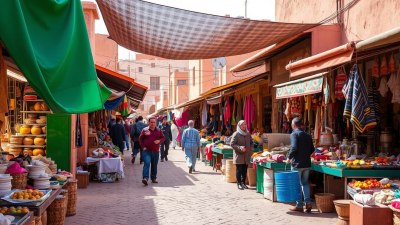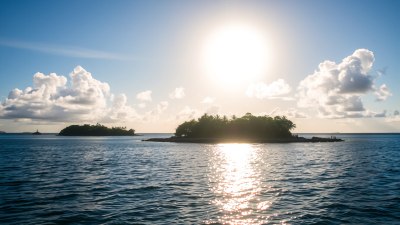The Wind Is the Guide Through Sand Dunes in Namibia
Explore how the wind shapes remarkable sand dunes in Namibia and guides your adventure through the mesmerizing landscape.

Namibia, located in southwestern Africa, boasts some of the world's most awe-inspiring landscapes, with its famous sand dunes that seem to defy gravity and time. The Namib Desert, home to these towering dunes, is the oldest desert in the world, and it is here that the wind plays a vital role both in shaping the dunes and guiding adventurers across this vast sea of sand. The combination of wind, sand, and unique topography creates an environment unlike any other, drawing travelers and explorers from around the globe.
The iconic Sossusvlei and Deadvlei areas within the Namib Desert are characterized by stunning red and orange sand dunes that stand as tall as 300 meters. These towering formations are a testament to the relentless power of nature. The wind is the primary sculptor of these dunes, constantly shifting and reshaping them over time. This dynamic interplay between sand and wind is what gives the Namibian landscape its distinct character, making it a haven for photographers and adventurers alike.
The Formation of Sand Dunes
Sand dunes are formed through the accumulation and compaction of sand, primarily driven by the effects of wind. The process begins with the erosion of rocks, which breaks down into smaller particles that are transported by wind. As the wind blows, it carries these sand grains and deposits them in areas where the wind speed decreases, allowing the sand to accumulate. Over time, these deposits grow into the majestic dunes we see today.
In Namibia, the predominant wind direction, known as the 'trade winds,' plays a critical role in influencing the shape of the dunes. The interaction between the direction of the wind and the topographical features of the land leads to various dune formations, such as star dunes, crescent-shaped barchans, and linear dunes. These shapes reflect the complex relationship between wind patterns and the natural landscape, creating an ever-evolving scenario that captivates visitors.
The Role of Wind in Navigation
For many adventurers exploring the Namib Desert, understanding the wind's role is essential for navigating the vast terrain. Unlike traditional landscapes, where navigation might rely on trees or roads, the dunes present a unique challenge. The wind can create ephemeral paths or even obscure familiar landmarks, urging explorers to adopt their intuition and learn how to read the subtle signs left behind.
Travelers need to anticipate changes in wind patterns and weather conditions, as these factors can significantly impact not only their course but also their safety. Wind can change direction and intensity, making it crucial to stay alert and adapt to the landscape. Though the endless expanse of the desert may initially appear uniform, the slight variations in color, texture, and the presence of vegetation can serve as natural guides, revealing the influences of wind.
Exploring Sossusvlei
The Sossusvlei area features some of the most photographed dunes in the world, where the vastness of the desert meets the stark beauty of towering red sands. Hiking to the top of Dune 45 or Big Daddy provides breathtaking views of the expansive terrain; as the sun rises and sets, the sands appear to come alive, shifting colors and shadows. The mesmerizing sights are a product of the wind's influence, which has molded these colossal formations.
Visitors to Sossusvlei can partake in guided tours where more experienced adventurers can narrate the wind and its role in the region’s ecosystem. Guided hikes can also provide keen insights into how wind patterns affect the local flora and fauna, illustrating the delicate balance of life that can thrive amidst the inhospitable environment of the Namib Desert.
Deadvlei: A Story in Stillness
Just a short distance from Sossusvlei lies Deadvlei, an ancient clay pan that adds a stark contrast to the vibrant dunes. Once a lush area home to camel thorn trees, it became a desolate testament to climate change and the ever-shifting sands as the wind altered the landscape drastically over thousands of years. The trees, now ghostly silhouettes against the desert backdrop, stand frozen in time, their stark white trunks contrasting beautifully with the bright orange dunes.
The ambience of Deadvlei highlights how the wind controls everything from life to death, and in this area, the trees remain as witnesses to a once-thriving ecosystem, preserved by the very forces that transformed their world. Here, you can feel the stillness intermingled with the gentle rustle of wind, emphasizing the harsh yet beautiful realities of survival in this environment.
Adventure Activities Amidst the Dunes
The vastness of the Namib Desert invites numerous adventure activities, allowing travelers to engage with the landscape interactively. Sandboarding, a fun activity that mimics snowboarding but on sand dunes, offers adrenaline seekers a unique way to enjoy the dunes. Participants can carve their way down the slopes while racing against the wind, an exhilarating experience that highlights the playful nature of the environment.
Hot air balloon rides present another unique perspective, offering panoramic views of the rugged terrain while gently drifting with the wind. These flights often take place during sunrise, showering the earth with warm hues of gold and orange as the day begins. As the balloon ascends, it reveals a sprawling landscape blanketed in sand, showcasing the intricate patterns formed by wind throughout the ages.
The Impact of Wind on the Ecosystem
While the wind's role in shaping the landscape is well-documented, its impact on the ecosystem is equally significant. The movement of sand facilitated by the wind helps to seed the surrounding areas with nutrients and create microhabitats that support various forms of life. Insects, reptiles, and unique plants have adapted to the arid climate, relying on the wind to distribute their seeds across the landscape.
One notable plant is the welwitschia, which has become symbolic of the Namib Desert. This ancient plant can live for over a thousand years and relies on dew and fog for survival, showcasing the delicate balance of life sustained by the ever-present wind. These plants create pockets of life in the desert, proving that even the harshest environments can cultivate a resilient ecosystem.
Challenges of Exploring the Desert
While the wind guides adventurers through the landscape, it also presents challenges. Sandstorms can sweep through the desert unexpectedly, significantly reducing visibility and creating hazardous conditions. Pre-planning and being aware of weather conditions are essential when embarking on an excursion in the Namib Desert. Travelers should equip themselves with appropriate gear to protect against harsh winds and sun exposure.
Furthermore, staying hydrated is paramount, as the dry environment can lead to rapid dehydration. Carrying enough water and ensuring frequent breaks in shaded areas can make a significant difference in safety and enjoyment levels while paddled among the stunning dunes.
Cultural Significance of Wind in Namibia
The wind is not only a geographical phenomenon in Namibia but also a cultural one. Indigenous communities, such as the San people, have lived in harmony with the desert for centuries and possess extensive knowledge about the environment and its elements. They understand the wind's patterns and use this knowledge to enhance their survival skills, including hunting and gathering.
Through storytelling and traditional practices, these communities pass on key insights about the wind and its significance in daily life. Navigational skills, understanding flora and fauna, and interpreting weather patterns are just a few crucial elements that reflect the deep relationship between the people and their environment. This cultural heritage enriches the experience of exploring the Namib Desert, painting a stunning picture of human ingenuity amidst the challenges posed by nature.
The Future of the Namib Desert
As climate change continues to impact ecosystems around the world, the Namib Desert is not immune to these changes. The region's delicate balance is under threat, and both tourists and locals must strive to preserve its beauty for future generations. Responsible tourism practices can help mitigate the effects of foot traffic, littering, and other impacts that can disrupt the natural dynamics of the desert.
Education and awareness can empower visitors to approach the landscape with respect and understanding. By acknowledging the vital role of the wind in shaping not only the dunes but the entire ecosystem, travelers can foster a deeper connection to this extraordinary wilderness.
In conclusion, the wind is indeed the guide through the sand dunes in Namibia, serving as both a navigator and a sculptor of its breathtaking landscapes. Its influence is deeply woven into the ecological fabric and cultural stories of the region, creating a rich tapestry that deserves exploration and preservation. Every footstep taken in the Namib Desert unveils the stories held within the sands, whispering secrets of the past while inviting a future filled with adventure and discovery as we learn to read the signs and follow the gentle whispers of the desert wind.











